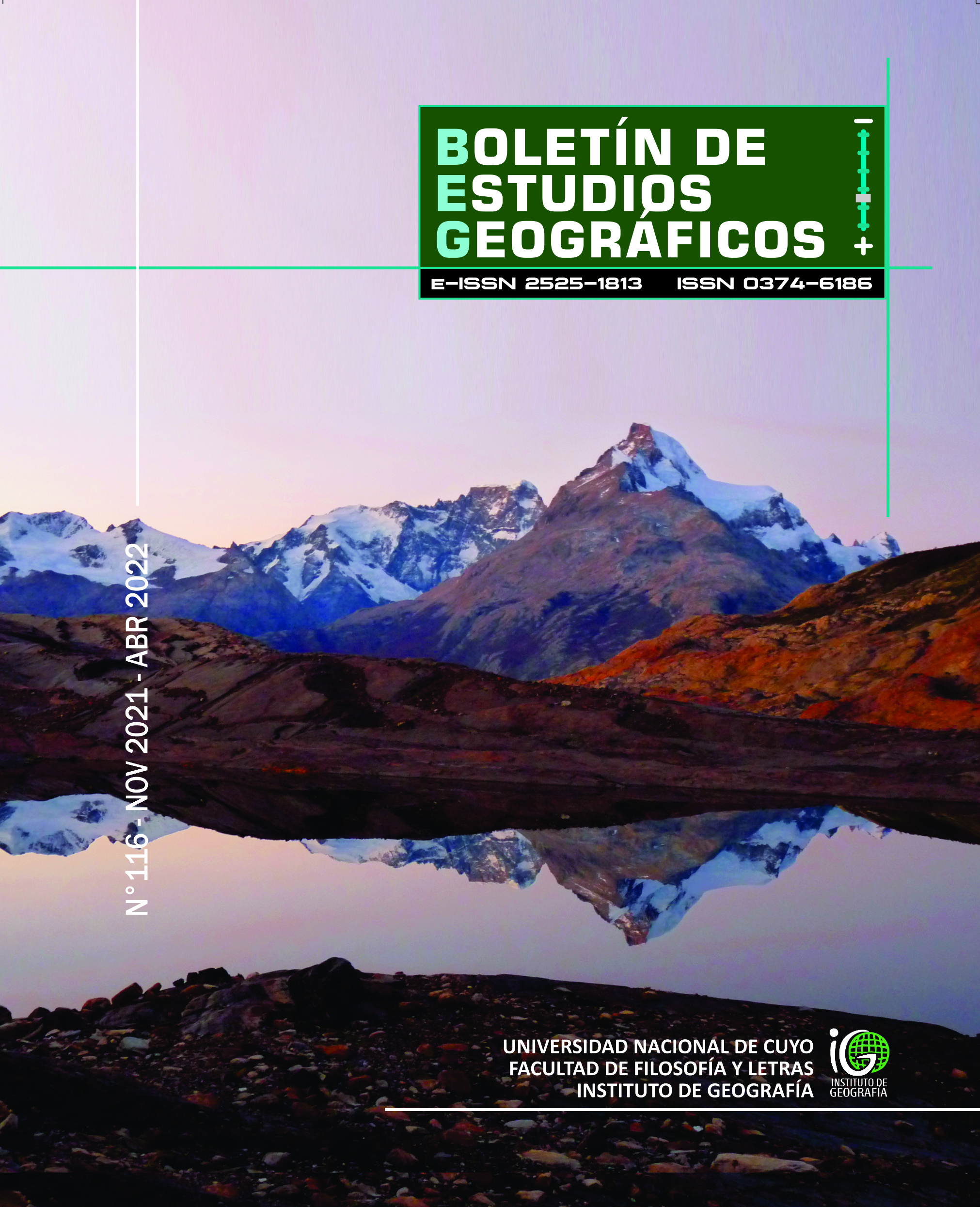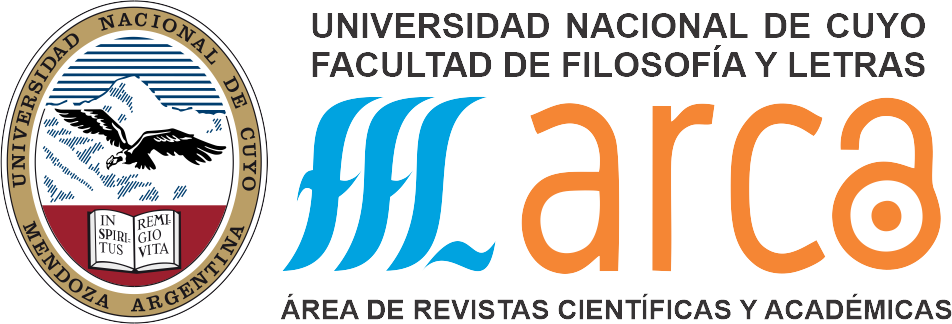Cuantificación del déficit hidrológico reciente en la región de Cuyo a partir de indicadores de caudales bajos
DOI:
https://doi.org/10.48162/rev.40.006Palabras clave:
sequía hidrológica, embalses, Andes Centrales, Cuyo, gestión de los recursos hídricosResumen
Esta investigación realiza una cuantificación del déficit en los caudales superficiales de los principales ríos de la región de Cuyo, asociado a la extraordinaria sequía hidrológica registrada desde el año 2010. Estos déficits presentan valores récord en el contexto
de los últimos 50 años, en particular durante el año hidrológico 2019/20. Las diferencias regionales en los valores de déficit acumulado permiten establecer que la mayor severidad se observó en las cuencas de los ríos Atuel y Colorado, las cuales en
promedio registraron caudales por debajo del percentil de excedencia del 80% (Q80) durante el período 2010/11-2019/20. A partir de la estandarización del déficit acumulado por el volumen de los embalses de la región, se obtuvo una medida de fácil interpretación y aplicación para el monitoreo y la toma de decisiones en relación al impacto de la sequía hidrológica en la disponibilidad de agua dulce regional.
Citas
Almazroui, M., Ashfaq, M., Islam, M.N., Rashid, I.U., Shahzad, K., Abid, M.A., O’Brien, E., Ismail, M., Reboita, M.S. Sörensson, A.A., Arias, P.A., Alves, L., Tippett, M.K., Saeed, S., Haarsma, R., Doblas-Reyes, F.J., Saeed, F., Kucharski, F., Nadeem, I., Silva-Vidal, Y., Rivera, J.A., Ehsan, M.A., Martínez-Castro, D., Muñoz, A.G., Ali, M.A., Coppola, E. & Sylla, M.B. (2021). Assessment of CMIP6 models performance and projected temperature and precipitation changes over South America. Earth Systems and Environment, 5, 155-183. doi: https://doi.org/10.1007/s41748-021-00233-6
Beyene, B. S., Van Loon, A. F., Van Lanen, H. A. J. & Torfs, P. J. J. F. (2014). Investigation of variable threshold level approaches for hydrological drought identification. Hydrol. Earth Syst. Sci. Discuss., 11, 12765–12797. doi: https://doi.org/10.5194/hessd-11-12765-2014
Boyé, H. & de Vivo, M. (2016). The environmental and social acceptability of dams. Field Actions Science Reports, 14, 32-37.
Byzedi, M., Saghafian, B., Mohammadi, K. & Siosemarde, M. (2014). Regional analysis of streamflow drought: a case study in southwestern Iran. Environ. Earth Sci. 71, 2955–2972. doi: https://doi.org/10.1007/s12665-013-2674-7
Cabré, F. & Nuñez, M. (2020). Impacts of climate change on viticulture in Argentina. Reg. Environ. Change, 20, 12. doi: 10.1007/s10113-020-01607-8
Caillouet, L., Vidal, J.-P., Sauquet, E., Devers, A. & Graff, B. (2017). Ensemble reconstruction of spatiotemporal extreme low-flow events in France since 1871. Hydrol. Earth Syst. Sci. 21, 2923–2951. doi: https://doi.org/10.5194/hess-21-2923-2017
Clausen, B. & Pearson, C. P. (1995). Regional frequency analysis of annual maximum streamflow drought. Journal of Hydrology 173, 111-130. doi: https://doi.org/10.1016/0022-1694(95)02713-Y
Crespo, S. A., Fernandoy, F., Cara, L., Klarian, S. & Lavergne, C. (2020). First snow, glacier and groundwater contribution quantification in the upper Mendoza River basin using stable water isotopes. Isotopes in Environmental and Health Studies, 56(5-6), 566-585. doi: https://doi.org/10.1080/10256016.2020.1797713
Di Baldassarre, G., Mazzoleni, M. & Rusca, M. (2021). The legacy of large dams in the United States. Ambio. doi: https://doi.org/10.1007/s13280-021-01533-x
Di Baldassarre, G., Wanders, N., AghaKouchak, A., Kuil, L., Rangecroft, S., Veldkamp, T. I. E., Garcia, M., van Oel, P. R., Breinl, K. & Van Loon, A. F. (2018). Water shortages worsened by reservoir effects. Nature Sustainability, 1, 617-622. doi: https://doi.org/10.1038/s41893-018-0159-0
Dracup, J. A., Lee, K. S. & Paulson, E. G. (1980). On the definition of droughts. Water Resources Research, 16(2), 297-302. doi: https://doi.org/10.1029/WR016i002p00297
Dussaillant, I., Berthier, E., Brun, F., Masiokas, M., Hugonnet, R., Favier, V., Rabatel, A., Pitte, P. & Ruiz, L. (2019). Two decades of glacier mass loss along the Andes. Nat. Geosci., 12, 802-808. doi: https://doi.org/10.1038/s41561-019-0432-5
Ehsani, N., Vörösmarty, C. J., Fekete, B. M. & Stakhiv, E. Z. (2017). Reservoir operations under climate change: Storage capacity options to mitigate risk. Journal of Hydrology, 555, 435-446. doi: https://doi.org/10.1016/j.jhydrol.2017.09.008
Fleig, A. K., Tallaksen, L. M., Hisdal, H. & Demuth, S. (2006). A global evaluation of streamflow drought characteristics. Hydrol. Earth Syst. Sci. 10, 535–552. doi: https://doi.org/10.5194/hess-10-535-2006
Garreaud, R. D., Clem, K. & Veloso, J. V. (2021). The South Pacific Pressure Trend Dipole and the Southern Blob. Journal of Climate 34, 7661-7676. doi: https://doi.org/10.1175/JCLI-D-20-0886.1
Gusyev, M. A., Hasegawa, A., Magome, J., Kuribayashi, D., Sawano, H. & Lee, S. (2015). Drought Assessment in the Pampanga River Basin, the Philippines. Part 1: A Role of Dam Infrastructure in Historical Droughts. Actas del 21º Congreso Internacional sobre Modelado y Simulación (MODSIM 2015), Broadbeach, Queensland (Australia).
Hisdal, H., Stahl, K., Tallaksen, L. M. & Demuth, S. (2001). Have streamflow droughts in Europe become more severe or frequent? Int. J. Climatol. 21, 317-333. doi: https://doi.org/10.1002/joc.619
Hock, R., Bliss, A., Marzeion, B., Giesen, R., Hirabayashi, Y., Huss, M., Radic, V. & Slangen, A. (2019). GlacierMIP – A model intercomparison of global-scale glacier mass-balance models and projections. Journal of Glaciology, 65, 453-467. doi: https://doi.org/10.1017/jog.2019.22
Lauro, C., Vich, A. I. & Moreiras, S. M. (2019). Streamflow variability and its relationship with climate indices in western rivers of Argentina. Hydrol. Sci. J., 64(5), 607-619. doi: https://doi.org/10.1080/02626667.2019.1594820
Lauro, C., Vich, A. & Moreiras, S. M. (2016). Variabilidad del régimen fluvial en cuencas de la región de Cuyo. Geoacta, 40(2), 28-51.
Margariti, J., Rangecroft, S., Parry, S., Wendt, D. E. & Van Loon, A. F. (2019). Anthropogenic activities alter drought termination. Elem. Sci. Anth. 7: 27. doi: https://doi.org/10.1525/elementa.365
Martínez, R., Zambrano, E., Nieto, J. J., Hernández, J. & Costa, F. (2017). Evolución, vulnerabilidad e impactos económicos y sociales de El Niño 2015-2016 en América Latina. Investigaciones Geográficas, 68,65-78. doi: https://doi.org/10.14198/INGEO2017.68.04
Masiokas, M. H., Rabatel, A., Rivera, A., Ruiz, L., Pitte, P., Ceballos, J. L., Barcaza, G., Soruco, A., Bown, F., Berthier, E., Dussaillant, I. & MacDonell, S. (2020). A Review of the Current State and Recent Changes of the Andean Cryosphere. Front. Earth Sci. 8:99. doi: https://doi.org/10.3389/feart.2020.00099
Massone, H., Martinez, D., Vich, A., Quiroz Londoño, M., Trombotto, D. & Grondona, S. (2016). Snowmelt contribution to the sustainability of the irrigated Mendoza’s Oasis, Argentina: an isotope study. Environ. Earth Sci., 75, 520. doi: https://doi.org/10.1007/s12665-015-5141-9
Montaña, E., Diaz, H. P. & Hurlbert, M. (2016). Development, local livelihoods, and vulnerabilities to global environmental change in the South American Dry Andes. Reg. Environ. Change, 16, 2215-2228. doi: https://doi.org/10.1007/s10113-015-0888-9
Rivera, J. A., Otta, S., Lauro, C. & Zazulie, N. (2021). A decade of hydrological drought in Central-Western Argentina. Front. Water, 3, 640544. doi: https://doi.org/10.3389/frwa.2021.640544
Rivera, J. A., Naranjo Tamayo, E. & Viale, M. (2020). Water resources change in Central-Western Argentina under the Paris Agreement warming targets. Front. Clim., 2, 587126. doi: https://doi.org/10.3389/fclim.2020.587126
Rivera, J. A. & Arnould, G. (2020). Evaluation of the ability of CMIP6 models to simulate precipitation over Southwestern South America: climatic features and long-term trends (1901-2014). Atmospheric Research 241, 104953. doi: https://doi.org/10.1016/j.atmosres.2020.104953
Rivera J. A. & Penalba O. C. (2018). Distribución de probabilidades de los caudales mensuales en las regiones de Cuyo y Patagonia (Argentina). Aplicación al monitoreo de sequías hidrológicas. Meteorologica, 43(2), 25-46.
Rivera J. A., Araneo D. C., Penalba O. C. & Villalba R. (2018). Regional aspects of streamflow droughts in the Andean rivers of Patagonia, Argentina. Links with large-scale climatic oscillations. Hydrology Research 49(1), 134-149. doi: https://doi.org/10.2166/nh.2017.207
Rivera J. A., Araneo D. C. & Penalba O. C. (2017, a). Threshold level approach for streamflow droughts analysis in the Central Andes of Argentina: A climatological assessment. Hydrological Sciences Journal, 62(12), 1949-1964. doi: https://doi.org/10.1080/02626667.2017.1367095
Rivera J. A., Penalba O. C., Villalba R. & Araneo D. C. (2017, b). Spatio-temporal patterns of the 2010-2015 extreme hydrological drought across the Central Andes, Argentina. Water, 9(9), 652. doi: https://doi.org/10.3390/w9090652
Sharma, T. C. & Panu, U. S. (2012). Prediction of hydrological drought durations based on Markov chains: case of the Canadian prairies. Hydrological Sciences Journal 57(4), 705-722. doi: https://doi.org/10.1080/02626667.2012.672741
Smakhtin, V. U. (2001). Low flow hydrology: a review. Journal of Hydrology, 240, 147-186. doi: https://doi.org/10.1016/S0022-1694(00)00340-1
Spinoni, J., Barbosa, P., Bucchignani, E., Cassano, J., Cavazos, T., Christensen, J. H., Christensen, O. B., Coppola, E., Evans, J., Geyer, B., Giorgi, F., Hadjinicolaou, P., Jacob, D., Katzfey, J., Koenigk, T., Laprise, R., Lennard, C. H., Levent Kurnaz, M., Li, D., Llopart, M., McCormick, N., Naumann, G., Nikulin, G., Ozturk, T., Panitz, H.-J., Porfirio da Rocha, R., Rockel, B., Solman, S. A., Syktus, J., Tangang, F., Teichmann, C., Vautard,
R., Vogt, J. V., Winger, K., Zittis, G. & Dosio, A. (2020). Future global meteorological drought hotspots. A study based on CORDEX data. J. Climate, 33, 3635-3661. doi: https://doi.org/10.1175/JCLI-D-19-0084.1
Sun, P., Zhang, Q., Yao, R. & Wen, Q. (2019). Hydrological Drought Regimes of the Huai River Basin, China: Probabilistic Behavior, Causes and Implications. Water 11(11):2390. doi: https://doi.org/10.3390/w11112390
Sutanto, S. J. & Van Lanen, H. A. J. (2021). Streamflow drought: implication of drought definitions and its application for drought forecasting. Hydrol. Earth Syst. Sci., 25, 3991-4023. doi: https://doi.org/10.5194/hess-25-3991-2021
Tallaksen, L. M., Madsen, H. & Clausen, B. (1997). On the definition and modelling of stream-flow drought duration and deficit volume. Hydrological Sciences Journal 42(1), 15-33. doi: https://doi.org/10.1080/02626669709492003
Tate, E. L. & Freeman, S. N. (2000). Three modelling approaches for seasonal streamflow droughts in southern Africa: the use of censored data. Hydrological Sciences Journal 45(1), 27-42. doi: https://doi.org/10.1080/02626660009492304
Toum, E., Masiokas, M. H., Villalba, R., Pitte, P. & Ruiz, L. (2021). The HBV.IANIGLA Hydrological Model. The R Journal. doi: https://doi.org/10.32614/RJ-2021-059
Van Loon, A. F. (2015). Hydrological drought explained. WIREs Water, 2(4), 359-392. doi: https://doi.org/10.1002/wat2.1085
Van Loon, A. F. & Laaha, G. (2015). Hydrological drought severity explained by climate and catchment characteristics. Journal of Hydrology 526, 3-14. doi: https://doi.org/10.1016/j.jhydrol.2014.10.059
Van Loon, A. F., Tijdeman, E., Wanders, N., Van Lanen, H. A. J., Teuling, A. J. & Uijlenhoet, R. (2014). How climate seasonality modifies drought duration and deficit. J. Geophys. Res. Atmos. 119, 4640–4656. doi: https://doi.org/10.1002/2013JD020383
Van Tiel, M., Van Loon, A. F., Seibert, J. & Stahl, K. (2021). Hydrological response to warm and dry weather: do glaciers compensate? Hydrol. Earth Syst. Sci., 25, 3245-3265. doi: https://doi.org/10.5194/hess-25-3245-2021
Van Tiel, M., Teuling, A. J., Wanders, N., Vis, M. J. P., Stahl, K. & Van Loon, A. F. (2018). The role of glacier changes and threshold definition in the characterisation of future streamflow droughts in glacierised catchments. Hydrol. Earth Syst. Sci. 22, 463–485. doi: https://doi.org/10.5194/hess-22-463-2018
Vich, A. I. J., Norte, F. A. & Lauro, C. (2014). Análisis regional de frecuencias de caudales de ríos pertenecientes a cuencas con nacientes en la Cordillera de los Andes. Meteorologica, 39(1), 3-26.
Villamayor, J., Khodri, M., Villalba, R. & Daux, V. (2021). Causes of the long-term variability of southwestern South America precipitation in the IPSL-CM6A-LR model. Clim. Dyn.doi: https://doi.org/10.1007/s00382-021-05811-y
Zazulie, N., Rusticucci, M. & Raga, G. B. (2018). Regional climate of the Subtropical Central Andes using high-resolution CMIP5 models. Part II: future projections for the twenty-first century. Clim. Dyn., 51, 2913-2925. doi: https://doi.org/10.1007/s00382-017-4056-4
Zelenhasić, E. & Salvai, A. (1987). A method of streamflow drought analysis. Water Resour. Res., 23(1),156-168. doi: https://doi.org/10.1029/WR023i001p00156
Zhao, W., Guan, X., Zhang, Z., Wang, Z., Wang, L. & Mamer, E. A. (2021). Development of flow-durationfrequency curves for episodic low streamflow. Advances in Water Resources 156, 104021. doi: https://doi.org/10.1016/j.advwatres.2021.104021
Publicado
Cómo citar
Número
Sección
Licencia

Esta obra está bajo una licencia internacional Creative Commons Atribución-NoComercial 4.0.



























